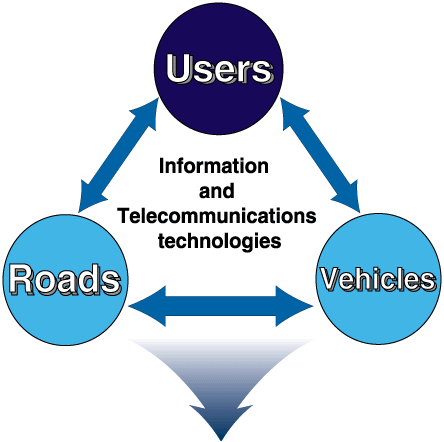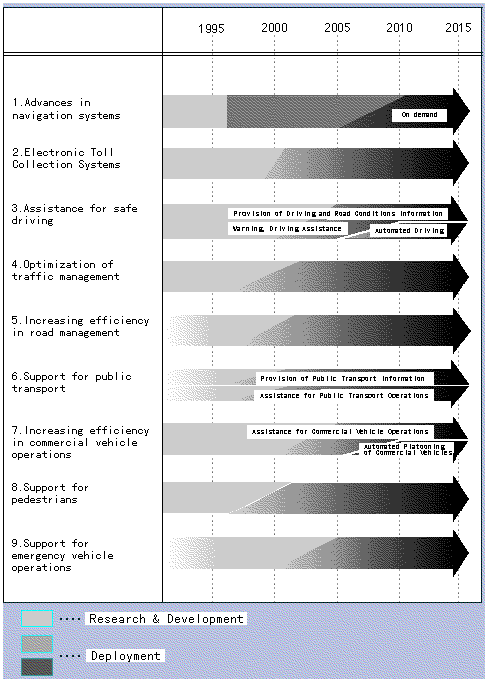

ITS is appreciated as one of the most promising multimedia businesses, and the potential market is estimated about 50 trillion yen (by VERTIS).
*ITS:Intelligent Transport Systems

Nine Development Areas of ITS (Development)
 Electronic toll collection systems
Electronic toll collection systems  Assistance for safe driving
Assistance for safe driving  Optimization of traffic management
Optimization of traffic management  Increasing efficiency in road management
Increasing efficiency in road management  Support for public transport
Support for public transport  Increasing efficiency in commercial vehicle operations
Increasing efficiency in commercial vehicle operations  Support for pedestrians
Support for pedestrians  Support for emergency vehicle operations
Support for emergency vehicle operations ITS User Services
ITS user services are set by allocating users for each of the nine different development fields in accordance with individual users' needs and conditions under which these needs arise. Framework of ITS User Services
|
User Services |
Development Areas |
Viewpoints for User Service Specification |
||
|
Main Users |
Needs |
Conditions |
||
| (1) Provision of route guidance/ traffic information | 1.Advances in navigation systems | Drivers | To obtain traffic information from navigation systems | Travel from departure points to destinations |
| (2) Provision of destination-related information | Selecting and obtaining information on destination | |||
| (3) Electronic toll collection | 2.Electronic toll collection systems | Drivers, carriers, and management agencies | Automatic toll exchange without stopping | (Toll) payment at toll gates |
| (4) Provision of driving and road conditions information | 3.Assistance for safe driving | Drivers | Safe driving | Recognition of traffic conditions |
| (5) Danger warning | Recognition of hazardous conditions | |||
| (6) Assistance for driving | Operation to avoid hazardous conditions | |||
| (7) Automated highway systems | Automated driving | |||
| (8) Optimization of traffic flow | 4.Optimization of traffic management | Drivers and management agencies | Optimization of traffic flow | Traffic management |
| (9) Provision of traffic restriction information on incident management | Adequate measures against traffic accidents | |||
| (10) Improvement of maintenance operations | 5.Increasing efficiency in road management | Management agencies | Prompt and adequate management of road maintenance | Road management |
| (11) Management of special permitted commercial vehicles | Drivers, carriers, and management agencies | Prompt and adequate issueance of permits for special vehicle passage | ||
| (12) Provision of roadway hazard information | Drivers and management agencies | Adequate resporse to natural disasters, etc. | ||
| (13) Provision of public transport information | 6.Support for public transport | Public transport passengers | Optimal use of different transport modes | Use of public transport |
| (14) Assistance for public transport operations and operations management | Carriers and public transport passengers | More convenient public transport, more efficient management and safer transport | Implementation of traffic operation management and priority control | |
| (15) Assistance for commercial vehicle operations management | 7.Increasing efficiency in commercial vehicle operations | Carriers | Efficient collection and delivery, and safer transport | Implementation of commercial vehicle operations management |
| (16) Automated platooning of commercial vehicles | More efficient transport | |||
| (17) Pedestrian route guidance | 8.Support for pedestrians | Pedestrians and cyclists | More convenient travel | Moving on foot, by bicycle, etc. Travel by walking, etc. |
| (18) Vehicle-pedestrian accident avoidance | Safer travel | |||
| (19) Automatic emergency notification | 9.Support for emergency vehicle operations | Drivers | Request for prompt and accurate rescue | Request for emergency relief |
| (20) Route guidance for emergency vehicles and support for relief activities | Drivers | Prompt and adequate route guidance to disaster sites | Restoration and relief activities | |
ITS Development and Deployment Milestones
ITS Development and Deployment Milestones

Relation Between ITS and Japan's Standard of Living
ITS is an advanced information network system for road traffic indispensable to the national lifestyle. Thus, in accordance with its deployment, Japan's standard of living is expected to improve greatly in all phases of transport safety and amenities. The relation between ITS and the national lifestyle in the 21st century is assumed as described below.
(1) First Phase (around 2000)
"Service Start of Part of Leading Systems Including the Navigation System" -- Beginning of ITS
In this period, which is the initial stage of ITS, traffic information will be distributed via VICS and similar systems which have already begun service. Traffic congestion information and optimum routes will be displayed on the in-vehicle navigation system so that the driver can achieve pleasant travel including travel time reduction. In the last half of the first phase, electronic toll collection will be started so that traffic congestion at the tollgate will begin to be eliminated.
(2) Second Phase (around 2005)
"Start of User Services" -- Traffic System Revolution
In this period of the 21st century, user services of ITS will be introduced gradually, starting a traffic system revolution. Information distributed to the users by ITS will include service information and public transport information about the destination, which will have enhanced content to further improve the user services. For example, when a trip is being planned, a destination that meets the stated needs and requests of the user is retrieved such that the optimum route and transport facilities up to the destination can be easily selected by considering travel time and other important factors.
The number of traffic accidents on the expressways and ordinary roads will be reduced by supporting the driver's safe driving and improving the pedestrian's safety. If a traffic accident occurs, quick notification and proper traffic restrictions will prevent further damage. Quick response of emergency and rescue activities will save the life of a person who would have not survived in the traditional situation.
On the other hand, the fixed-schedule character of public transport organizations will be maintained and information services will be enhanced to greatly improve the convenience of public transportation. An attempt will be made to improve the efficiency of transactions concerning transport operators so that the nation will benefit from reduced logistics costs.
(3) Third Phase (around 2010)
"Advances in ITS and Enhanced Social System" -- Automated Highway Systems- Realization of a Dream
In the third phase, ITS is advanced to a higher level. As well as the spread of infrastructure and in-vehicle equipment, legal and social systems will be enhanced to firmly establish ITS as a social system, so that the effects will be nationwide. With the realization of further advanced functions, automated driving will be started for full-scale service; the inside of the vehicle will be a safer and more pleasant place.
(4) Fourth Phase (after 2010)
"Maturity of ITS" -- Innovation of Social Systems
In the fourth phase, which is the final period of this project, all systems of ITS will already have been deployed. A full-scale advanced information and telecommunications society will be established with the nationwide optic fiber network and innovative social systems.
In this period, the number of automated driving users will have started to increase such that automated driving will be established as a general system. ITS will come to a period of maturity and be accepted by the nation as a basic system pertinent to road and other means of transport. With full-scale ITS deployment, it is expected that the number of deaths caused by traffic accidents will greatly decrease from that of the present in spite of increased traffic volumes and density. All roads including those within cities will have less traffic congestion, enabling pleasant and smooth travel. In addition, a reduction in business traffic will enable harmonization with the roadside environment and the global environment.
|
| |
All Rights Reserved, Copyright © 2004-2008 Ministry of Land, Infrastructure, Transport and Tourism |